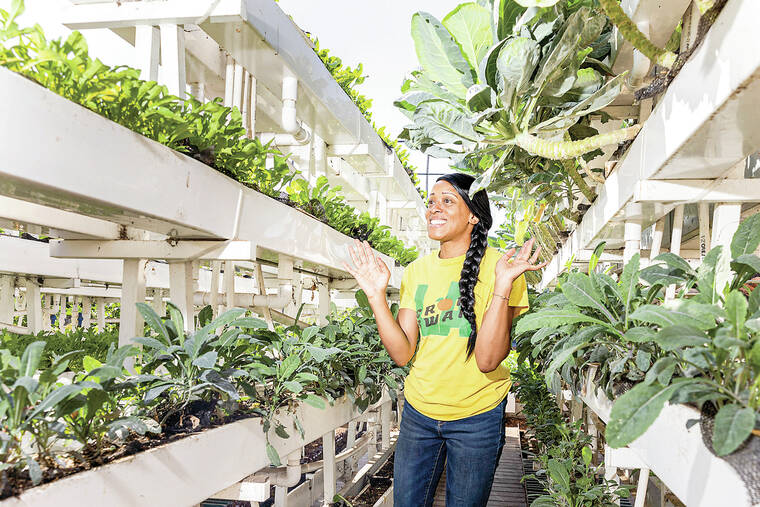Growing food instead of lawns in California front yards
On a corner lot in Leimert Park in dusty South Los Angeles, not far from Obama and Crenshaw boulevards, sits a curiosity that’s wildly different from all the neighboring grassy yards. Abundant and lush, it looks like a mash-up between a country idyll and something dreamed up by Dr. Seuss.
Tangles of grapes and blackberries grow in clusters along a trellis. Leafy rows of basil, sweet potatoes and mesclun spring from raised garden troughs. Most striking are corridors of elevated planters stacked four high, like multilevel bunk beds, filled with kale, cabbage, arugula, various lettuces, eggplants, tatsoi and collard greens.
ADVERTISING
Run by a gardening wizard named Jamiah Hargins, this wee farm in the front yard of his bungalow provides fresh produce for 45 nearby families, all while using a tiny fraction of the water required by a lawn.
At just 2,500 square feet, this farm forms the heart of Hargins’ nonprofit, Crop Swap LA, which transforms yards and unused spaces into microfarms. It runs three front yard farms that provide organic fruits and vegetables each week to 80 families, all living in a 1-mile radius, and often with food insecurity. Rooted in the empowering idea that people can grow their own food, Crop Swap LA has caught on, with a waitlist of 300 residents wanting to convert their yards into microfarms.
The project began inadvertently in 2018, when Hargins, who grew up on military bases and worked as an options trader and headhunter, decided to grow his own food. He didn’t have much experience, but he had a strong incentive. He wanted fresh produce for his baby daughter, and there weren’t great options around.
Hargins hammered together a garden bed out of old wood, filled it with soil, and began experimenting. He spent long hours outside, at daybreak and at night, watching how seedlings and plantings responded to growing in different parts of the yard. “He just took time to pay attention,” said his wife, Ginnia Hargins.
Their little garden grew, and eventually produced so much Swiss chard, broccoli, cauliflower and callaloo that Jamiah Hargins organized a produce exchange with other urban gardeners as well as with neighbors with bountiful fruit trees. He called the initiative Crop Swap LA.
The project has expanded to three front yard microfarms growing in adjoining neighborhoods and transformed into a nonprofit organization.
The mini farms bring environmental benefits, thanks to irrigation and containment systems that capture and recycle rain. That allows the farms to produce thousands of pounds of food without using much water.
“Some people pay $100 a month on their water because they’re watering grass, but they don’t get to eat anything, no one gets any benefit from it,” Hargins said one recent early autumn evening outside his home and farm, stopping every now and then to wave at neighbors driving by.
Hargins estimated that his microfarm uses 98% less water than the lawn that once filled the space. The water bill for the family’s three-bedroom house and microfarm is just $45 a month, he said.
Hargins installed solar panels on the roof to help power the house and the irrigation system, which includes 35 pumps. The produce is grown in a mixture of soil combined with compost, rock dust and other organic matter.
Microfarm transformations are not cheap. With $4 million from the state in 2021, Hargins spent $150,000 to create his farm and expand the nonprofit, which he now runs full time with a staff of 13. Maintaining the three farms is also labor-intensive, but worth it, Hargins said.
“We’re housing nature,” he said, “and we’re feeding families.”
Crop Swap LA operates much like farm shares, with subscribers paying for a bag of fresh fruit, herbs and vegetables each week.
Not every Angeleno can join. Hargins stipulates that recipients live within a 1-mile radius of the farms, to keep the food hyperlocal and reduce vehicle emissions associated with transportation. Priority is given to the elderly, disabled veterans, single parents, people fostering or adopting children, those living at or below the poverty level and recent immigrants. About 10% of members pay using food stamps, Hargins said.
Though the produce grows in front yards, there hasn’t been any theft, he said, not counting a few miscreant squirrels.
Crop Swap LA began to spread beyond Hargins’ garden in 2020. His wife, now a school principal, was chatting with a teacher, Mychal Creer, who had a grassy front yard but wanted to conserve water and grow something more useful than a lawn.
Ginnia Hargins introduced him to her husband, who was in the process of securing a $50,000 grant from the nonprofit LA2050 to expand Crop Swap LA. Using $35,000, he and Creer ripped out the Creers’ front lawn, and installed underground rainwater catchments and a solar-powered irrigation system. They set out long rows of fabric tubes that functioned as garden beds, sowing them with around 2,000 plants. The sloped and triangular yard sits prominently at an intersection and was named Asante, Swahili for thank you. It draws curious passersby along with pollinating insects and hummingbirds.
“It’s been an eco-friendly place for the animals and for the humans,” said Creer, who has since left his teaching job to become Crop Swap LA’s head farmer. “I would love to see all these lawns here to eventually be growing food.”
This article originally appeared in The New York Times.
© 2024 The New York Times Company


